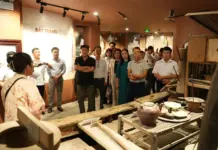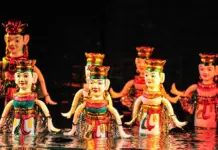The ups and downs of Hanoi’s historical landscape have transformed the very places where, seven decades ago, its soldiers and citizens heroically defended their city and celebrated the victorious army’s arrival. Yet these sites continue to bear witness to the timeless stories of Hanoi’s rich past.
**The Five City Gates:**
| Quan Chuong Gate stands tall on an early autumn day. Photo: Khanh Huy/The Hanoi Times |
The iconic image of Hanoi’s five city gates has become forever etched in the memory of its liberation day. As composer Van Cao poetically penned in his song “Tien Ve Ha Noi” (Advance to Hanoi), “Five city gates heartily welcome the returning army…” It is intriguing to note that this popular song was written in 1949, five years before the momentous event it foretold.
As writer Nguyen Ngoc Tien remarked, “Composer Van Cao’s prophecy came true when five columns of the Vietnamese army entered Hanoi in early October 1954. From October 7 to 9, they marched into the city through the gates of Cau Giay, Cau Den, Yen Phu, Hang Dau, and Thuy Khue.”
Sadly, by the end of the 19th century, most of Hanoi’s city gates, except for the resilient Quan Chuong Gate, had been demolished one by one. Today, visitors can still behold the ancient moss-covered wall and gate, bearing the inscription “Dong Ha Gate,” its official name, on Hang Chieu Street in Hoan Kiem District.
**Long Bien Bridge:**
| Hanoi’s iconic Long Bien Bridge. Photo: Tran Thanh Hoa |
Long Bien Bridge stands as a silent sentinel, bearing witness to the liberation of Hanoi. On the misty night of February 17, 1947, the 102nd Capital Regiment stealthily crossed the Red River in small units beneath this very bridge. Evading the French guards, about 1,000 soldiers preserved their strength for the ensuing 9-year anti-French resistance war.
On October 9, 1954, the final French troops withdrew from Hanoi, crossing this same bridge to Gia Lam District and onward to Haiphong City, as stipulated in the Geneva Accords. The Capital Regiment’s presence at the bridge’s end was met with jubilant cheers and applause from the people of Hanoi lining the streets of Hang Dau and Tran Nhat Duat.
During the anti-US resistance war, Long Bien Bridge became a prime target for US Air Force bombings. Despite several renovations and the construction of more modern bridges like Nhat Tan and Vinh Tuy, Hanoi’s beloved rusting Long Bien Bridge remains a testament to its historical, cultural, and architectural significance, attracting tourists from near and far.
**Hanoi Flag Tower:**
| The Hanoi Flag Tower stands proudly on Dien Bien Phu Street, Ba Dinh District. Photo: Duy Khanh/ The Hanoi Times |
On October 10, 1954, Hanoi’s liberation was celebrated with a flag-raising ceremony in the Doan Mon courtyard of the Thang Long Imperial Citadel (then known as the Flag Tower Courtyard). The atmosphere was electric with joy and pride.
Hosted by the Hanoi City Political-Military Committee, with military units and tens of thousands of citizens in attendance, the ceremony commenced with the playing of the national anthem by the military band. As the Opera House siren sounded, the yellow-starred red flag was hoisted atop the Flag Tower, fluttering proudly in the wind.
At this historic event, the people of Hanoi heard the words of President Ho Chi Minh’s appeal to the capital’s citizens on Liberation Day, read by Committee Chairman Vuong Thua Vu. In 1989, the Flag Tower was officially recognized as a historical relic by the State. Today, it stands as an iconic landmark and the first stop on tours of the Thang Long Imperial Citadel.
**Hanoi Opera House:**
| The Hanoi Opera House. Photo: Dang Dung/ Yeu Ha Noi Group |
The Hanoi Opera House and August Revolution Square hold cultural and historical significance. Beyond being a venue for the arts, this site has played host to many pivotal events. The first Parliament of the Democratic Republic of Vietnam convened here on March 2, 1946. After the capital’s liberation, the Opera House again served as a meeting place for the legislative body from March 20 to 26, 1955, until the construction of Ba Dinh Hall in 1963.
Hanoians gathered here to greet the triumphant army with portraits of President Ho Chi Minh, banners, and red flags with yellow stars. It was also from here that the siren sounded to mark the historic flag-hoisting ceremony on October 10, 1954.
Following its restoration from 1995 to 1997, the Hanoi Opera House resumed its role as a prominent performing arts venue. It continues to host cultural activities and performances by Vietnamese and international troupes, showcasing folk art and traditional music. In 2011, the Hanoi Opera House and August Revolution Square were recognized as national historical and architectural relics by the Ministry of Culture, Sports, and Tourism.
**Hang Dao Street:**
| The Dong Lac Communal House on Hang Dao Street. Photo: Old Quarter Management Board |
On October 10, 1954, the Hanoi City Political-Military Committee, led by Brigadier General Vuong Thua Vu and Doctor Tran Duy Hung, alongside the Capital Regiment, Mechanized Infantry, and Artillery, made their entrance into the city via Hang Dao Street.
Le Suu, a resident of Hang Dao, captured the famous black-and-white photograph titled “Hang Dao Street on Takeover Day, October 54” when he was just 17 years old. His wife, Hoang Lan Huong, recalled the days leading up to the troops’ arrival, when their houses and streets were adorned with colorful papers, flags, banners, and flowers.
“People lined the streets, filled with happiness. Students in uniform waved the yellow-star red flags as the soldiers passed by to the cheers of the crowd,” she reminisced.
In 2003, the Hoan Kiem District People’s Committee inaugurated the Hang Dao – Dong Xuan Night Market as a walking street on weekend evenings. This market, offering handicrafts and Hanoi specialties, has become a new cultural attraction in the city. A stroll through the Old Quarter is incomplete without a walk down Hang Ngang, Hang Dao, Hang Duong, and Dong Xuan streets.
**Dong Xuan Market:**
| Dong Xuan Market. Photo: Dong Xuan Market Management Board |
Dong Xuan Market bears the scars of the 60-day and night battle for Hanoi in the winter of 1946-1947. The most intense clash occurred on February 14, 1947, when the French army laid siege to the market. According to Lieutenant General Vuong Thua Vu, the market was relentlessly bombarded for three days, encircled by over 400 French soldiers and combat vehicles. Their aim was to attack the Military Zone I command center and seize control of Hanoi.
Bravely holding their ground, the 101st Suicide Battalion of the Capital Regiment, with only 130 men remaining, fought to secure their positions and create a safe escape route for the Central Command during the retreat on the night of February 17, 1947.
Seven decades after the Winter Battle of 1946, Dong Xuan Market retains its classical style while embracing modern renovations. Bustling with activity all year round, it stands as the largest wholesale center in Northern Vietnam and the biggest market in Hanoi’s Old Quarter.
The Grand Cultural Extravaganza: A Festival of Peace and Unity
Nearly ten thousand citizens and representatives from diverse city forces united as participants in the rehearsal for the grand opening of the “Cultural Festival for Peace.” This highly anticipated event will commence at 7 AM sharp on the 6th of October, with the rehearsal ensuring a seamless and spectacular start to the festival.
Hanoi – A Thousand-Year-Old Cultural Epicenter
For centuries, the city has been renowned for its rich cultural tapestry, a vibrant heritage that has endured and flourished over time.
Hanoi’s Festival of the Ao Dai: A Cultural Celebration to Inspire and Promote Tourism
This autumn, Hanoi is set to celebrate the iconic ao dai, a timeless symbol of Vietnamese cultural identity. The city will host a series of cultural events, honoring the traditional dress and its enduring appeal, while also attracting tourists eager to immerse themselves in this rich cultural heritage.


.jpg)











